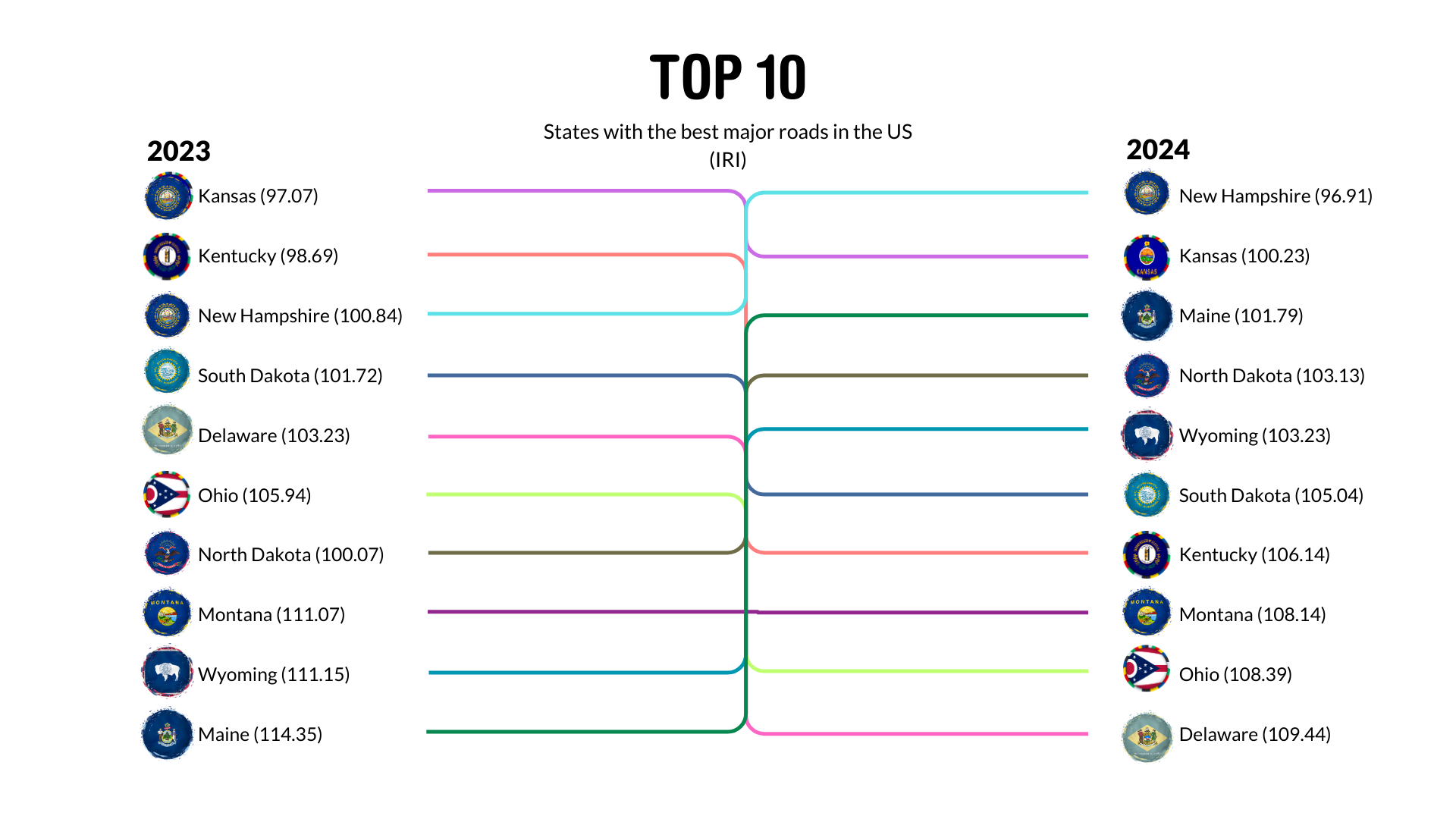Assessing 2024 US road quality with Connected Vehicle Data

Monitoring and maintaining road infrastructure is critical for transportation safety, efficiency, and economic vitality across the United States. Road roughness, measured by the International Roughness Index (IRI), serves as a key indicator of road quality and pavement health. Traditionally assessed through periodic field tests and sampling, road roughness can now be evaluated more comprehensively and frequently using connected vehicle data.
For the second year in a row, NIRA Dynamics has analysed road roughness across the US road network using aggregated data from connected vehicles. By applying advanced sensor fusion techniques to standard vehicle sensors, NIRA can generate daily IRI updates for nearly every mile of highway and arterial road nationwide. Here we will be presenting the latest findings and insights from the US road network.
National overview
In 2024, the national average IRI value across major road (road classes 2 and 3) segments was 120 inches per mile (in/mi). This represents a small downgrade from the 2023 national baseline of 116 in/mi. Highways also declined in quality, going from 104,6 in 2023 to 108 in 2024. While the overall US road network remains in good condition by global standards, there is significant state-by-state variation in road quality.
Interstate highways and expressways, had the lowest national average IRI of 108 in/mi. This indicates that the most critical roadway infrastructure is generally well-maintained. Road Classes 2 and 3, which cover major arterials and collector roads, had slightly higher average IRI values. It matches the European measurements well. To learn more about the European road roughness measurements, please read this article.
State Rankings
The table below shows the 2024 state rankings for overall road roughness, based on the weighted average IRI across all road classes. Lower IRI values correspond to smoother roads.

New Hampshire maintained its position as the state with the best overall road quality, with an average IRI of just 87 in/mi for highways and 97 in/mi for major roads. Kansas continues to be in the top. This is especially impressive given Kansas' large rural road network and freeze-thaw cycle. Maine, North Dakota and Wyoming round out the top 5, all with average IRI values below 105 in/mi for their major roads.
New Hampshire deserves recognition for the work they are doing with the roads. But why are they consistently in the top?
- Steady Preventive Maintenance - New Hampshire historically emphasizes preventive maintenance—such as regular crack sealing and resurfacing—rather than deferring repairs until the pavement is in dire condition. This proactive approach keeps road roughness comparatively low over time.
- Strategic Funding & Planning - Though not as large as some state-level infrastructure programs, New Hampshire’s capital improvement plans systematically allocate funds to critical corridors and bridges. This steady (if modest) funding helps prevent significant deterioration on priority roadways.
- Interstate & Regional Coordination - As part of the New England region, certain interstate corridors receive shared attention and resources from federal programs. New Hampshire’s Department of Transportation (NHDOT) collaborates with neighbouring states on multi-state routes, which can translate into well-maintained stretches of highway that span state lines.
- Smaller, More Manageable Network - New Hampshire is geographically smaller compared to many states, with fewer urban sprawls. A more compact roadway system can be easier to maintain, allowing repairs and resurfacing to keep pace with wear and tear.
- Climate Adaptation - Although New England winters can be harsh, New Hampshire’s road management strategies (salt application, snow removal, timely pothole repairs) are finely tuned to local climate challenges. Any additional funding or resource deployment after harsh winters tends to show up quickly in lower roughness measurements.
At the other end of the spectrum, Louisiana had the highest average roughness of 161 in/mi, indicating the poorest overall pavement conditions. Arizona, Texas, California and Rhode Island also fared poorly with average IRI exceeding 140 in/mi. Many of the roughest roads were found in states with large lane-mile inventories, heavy truck traffic, severe weather, and budget constraints.

Why Are Some States Improving While Others Decline?
Funding & Prioritization - States that invested heavily in resurfacing critical corridors saw noticeable drops in roughness. Maine and Wyoming’s improvements reflect recent or ongoing projects aimed at rural and high-traffic routes alike.
Climate & Weather Impact - Harsh winters in northern states can worsen roads, yet improvements in places like Maine show that sufficient funding can overcome these natural challenges. Conversely, warmer regions—such as Louisiana and Texas—may see road surfaces degrade quickly under heavy freight and extreme heat unless maintenance keeps pace.
Infrastructure Age & Usage - Older highway systems can require expensive overhauls; states underestimating maintenance needs see roughness climb. Booming states with high population growth (e.g., Texas, North Carolina) may struggle to keep road quality stable due to surging traffic volumes.
Conclusion
The 2023–2024 road quality metrics reveal clear winners and losers. Maine, Wyoming and Rhode Island are bright spots, showing that focused investments and timely maintenance can make a real difference. Meanwhile, states like Louisiana, New Mexico, Indiana and Texas face growing challenges—potentially from fast-expanding road networks, high traffic, or deferred upkeep. These results underscore the continuing need for targeted infrastructure strategies to prevent small issues from ballooning into larger road-quality crises.
Trying to determine exactly why a state has improved is very difficult. Many factors play a role, but it is likely that these are some of the factors:
Maine
- Targeted Bonds & Rural Focus - Recurring transportation bonds have funded extensive highway and bridge repairs, including rural corridors historically prone to neglect.
- Winter Preparedness - Improved winter maintenance and proactive resurfacing efforts (especially post-freeze/thaw cycles) have helped smooth out roads across the state.
Wyoming
- Smart Use of Federal Grants - Leveraging BUILD/RAISE and other federal programs has accelerated repairs on critical freight and energy sector routes.
- Quick Impact, Wide Reach - With fewer residents and well-chosen projects, Wyoming sees returns on investment faster, reducing roughness on both highways and major roads.
Rhode Island
- RhodeWorks Initiative - This program dedicates consistent funding to modernize highways and bridges, driving steady declines in roughness.
- Federal Boosts - IIJA funds and strategic tolling revenue have further propelled major resurfacing and reconstruction efforts, enhancing both urban and suburban road networks.
Overall, each state’s success reflects focused investment - whether through strategic bonds, targeted federal grants, or forward-looking programs like RhodeWorks—and a commitment to ongoing maintenance rather than waiting for severe degradation. These efforts demonstrate how timely, well-funded infrastructure policies can rapidly translate into smoother rides for drivers.
Connected vehicle data enables performance measurement
This state-by-state assessment of road roughness has significant implications for transportation policy, infrastructure investment, and public safety. Rough roads not only impact driver comfort and vehicle durability, but also contribute to excess fuel consumption, emissions, and crashes.
Connected vehicle data enables transportation agencies to continuously track statewide IRI metrics, identify regional disparities and hot spots, optimize treatment timing, and quantify the return on pavement investments. Making this road roughness data accessible to decision-makers and the public can spur performance-based approaches to road maintenance and help direct resources to where they are needed most.
Pavement preservation strategies guided by near real-time roughness data have the potential to improve safety outcomes, reduce vehicle operating costs, and increase infrastructure life spans. As road usage and vehicle technology evolve, harnessing connected vehicle insights will be key to keeping US roads in a state of good repair.




